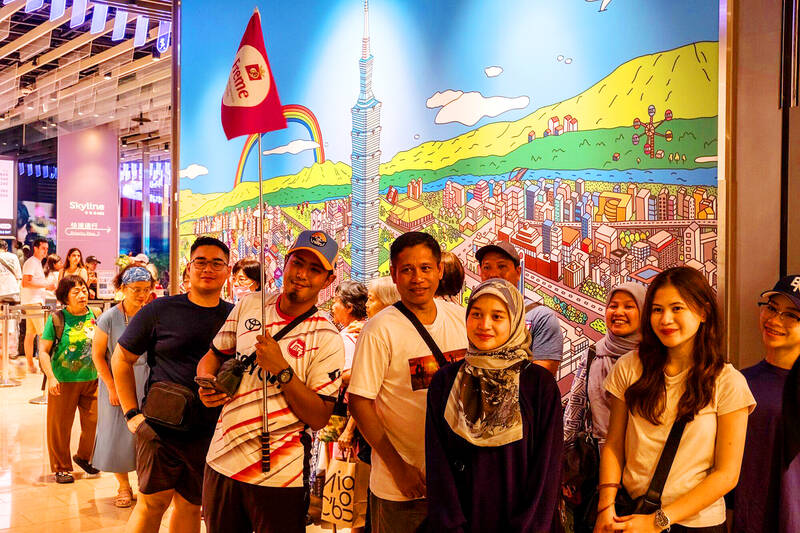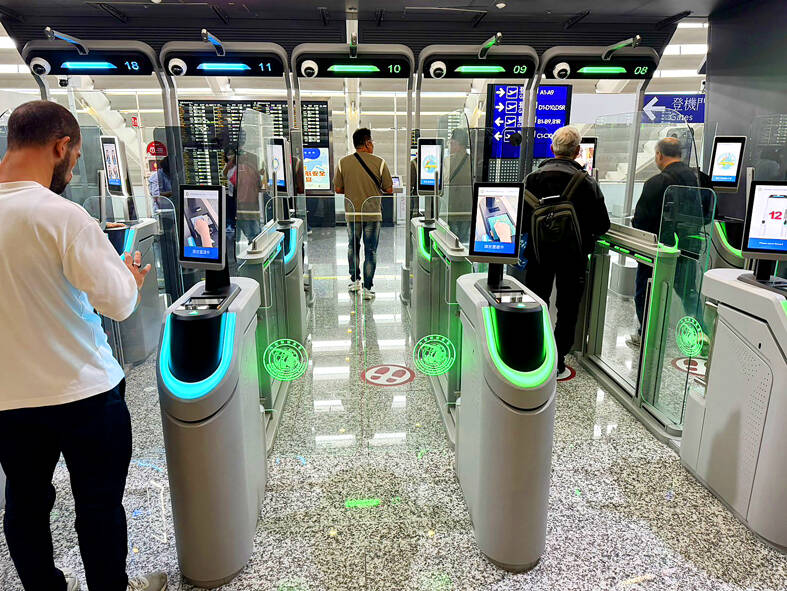Taiwan wants to lure higher-spending travelers from Southeast Asia as Chinese arrivals dwindle, a shift that could reshape the island’s tourism industry.
Despite increasingly fraught relations across the strait, visitors from across Asia, and Southeast Asia in particular, are traveling to Taiwan in greater numbers than before the pandemic, first-quarter data from Taiwan’s Tourism Administration show.
The number of Thai visitors has risen 12 percent from the same period in 2019, according to the travel body, while Singapore’s is up 10 percent and Malaysia’s has reached pre-COVID levels.

Photo: Bloomberg 照片:彭博社
Hotel revenues and the number of local travel agencies have returned to where they were before the pandemic, a positive sign for the tourism sector despite the number of Chinese visitors remaining stubbornly low.
Tourists from Singapore and Malaysia in particular are seeking out more unique and higher-priced hotels, Lin Hsin-jen, the Tourism Administration’s deputy director-general, said in an interview. That helped propel the hotel industry’s total takings to NT$178 billion (US$5.5 billion) last year, surpassing NT$156 billion in 2019.
The trend, if it continues, could reshape a tourism sector long reliant on arrivals from China. This new pattern of spending stands in stark contrast to 10 years ago when China was the largest source of visitors, making up just over 40 percent of the tourists coming to Taiwan, mainly as part of tour groups.

Photo courtesy of Tourism Administration 照片:觀光署提供
Only around 99,000 Chinese came to Taiwan in the first quarter, compared to about 793,000 in the first three months of 2019, the tourism data show. In addition, China has taken coercive measures against Taiwan in recent months, including the seizure of a fishing boat, in an effort to pressure President William Lai. Lai rejects China’s claim to sovereignty over the island, asserting instead that Taiwan is a de facto independent nation.
Total visitor numbers to Taiwan were still down 30 percent in the first quarter compared to the same period in 2019. The pace of the island’s rebound comes as Asian neighbor and travel hotspot Japan saw a historic high in inbound tourists earlier this year as the yen weakened. Taiwan’s Tourism Administration is seeking to remedy this by promoting Taiwan in other parts of the world, including Japan and the US’ West Coast.
Japanese tourism into Taiwan is at just 69 percent compared to the first quarter of 2019, as more people stay home amid the currency weakness.

Photo: Chen Hsin-yu, Liberty Times 照片:自由時報記者陳心瑜
Taiwan is also looking to encourage the approximately six million travelers who transit through the island’s airports each year to enter Taiwan properly, according to the administration’s Lin, turning transfer passengers into tourists. Taiwan aims to reach 14 million visitors — up from a target of 10 million this year — and as much as NT$1 trillion in annual tourism revenue by 2028.
While tourism represents a tiny portion of Taiwan’s technology-focused, export-oriented economy, it does employ a significant number of people, especially in poorer rural and southern areas of the island. The growing number of travel agencies demonstrates that industry players remain hopeful tourism is rebounding.
Before 2019, 30 percent of visitors to the Taiwan Glass Gallery in Changhua county in the central part of the island were from China. Although there are almost no Chinese tourists now, travelers from Southeast Asia have driven attendance numbers up. Visitors have grown by 80 percent this year compared to 2019.

Photo courtesy of National Immigration Agency 照片:移民署提供
Different consumption habits are also having an impact. In the past, Chinese tourists typically visited in groups, spending less time at the gallery and only having time to purchase a quick cup of coffee. But as the number of individual travelers from countries like Singapore and Malaysia increases, visitors are staying longer and spending more in the gift shop.
Jiu Zhen Nan, a business selling pastries in airports and malls, has also managed to recover from the loss of Chinese shoppers, saying sales this year are returning to 2019’s level.
(Bloomberg)
隨著中國遊客人數減少,台灣希望吸引東南亞的高消費遊客,這項轉變可能會重塑台灣的旅遊業。
台灣觀光署第一季的數據顯示,儘管兩岸關係日益緊張,但來自亞洲各地,尤其是東南亞的遊客前往台灣的人數比疫情爆發前還多。
觀光署的數據顯示,到台灣的泰國遊客人數較2019年同期增加了12%,新加坡遊客增加了10%,馬來西亞遊客則已達到COVID疫情前的水平。
儘管中國遊客人數仍低,但旅館收入及本土旅行社數量已恢復至疫情前的水準,這對旅遊業來說是樂觀的跡象。
觀光署副署長林信任受訪時表示,新加坡和馬來西亞的遊客尤其傾向尋找更獨特、更高價的飯店。這有助於讓飯店業去年的總收入達到新台幣1,780億元(合55億美元),超過2019年的1,560億元。
如果這種趨勢持續下去,可能會重塑長期依賴中國遊客的旅遊業。這種新的消費型態與10年前形成鮮明對比,當時中國是台灣的最大遊客來源國,佔40%多一點,主要為團客。
旅遊數據顯示,第一季只有約99,000名中國人來到台灣,而2019年的前三個月有約793,000人。此外還有中國近數月對台灣的脅迫作為,包括扣押一艘漁船,以向新任總統賴清德施壓。中國聲稱對台灣擁有主權,賴清德拒絕接受,並堅持台灣是實質獨立的國家。
與2019年同期相比,第一季赴台遊客總數仍下降30%。今年稍早,隨著日圓貶值,台灣的亞洲鄰國、旅遊熱門地點日本的入境遊客數量創下歷史新高,台灣的遊客人數也隨之反彈。台灣觀光署為解決遊客人數下降問題,正向世界其他地區(包括日本及美國西岸)宣傳台灣。
目前赴台旅遊的日本人僅有2019年第一季的69%,這是因為日幣貶值,使得更多人留在國內。
林信任表示,每年經台灣機場轉機的旅客約有600萬,台灣也鼓勵這些旅客入境,希望將轉機旅客變成遊客。台灣的目標是到2028年遊客人數達到1,400萬人次(今年的目標為1,000萬人次),年度旅遊收入達到1兆元新台幣。
在台灣以科技為中心的出口導向經濟中,旅遊業雖然只佔一小部分,但它的確僱用了大量人員,尤其是在台灣較貧窮的農村及南部地區。旅行社數量的增加顯示,相關從業人員仍對旅遊業的復甦抱持希望。
2019年之前,位於台灣中部彰化縣的台灣玻璃館有30%的遊客來自中國。雖然現在幾乎沒有中國遊客,但來自東南亞的遊客卻帶動了參觀人數的增加。該館今年的到訪人數比2019年增加了80%。
不同的消費習慣也在產生影響。過去,中國遊客通常都是跟團參觀,在該館停留的時間較少,只有時間快速買一杯咖啡。但隨著來自新加坡和馬來西亞等國的散客數量增加,遊客在禮品店停留的時間更長,花費也更多。
在機場和商場銷售糕點的舊振南也成功從中國顧客的流失中恢復過來,表示今年的銷售額已恢復到2019年的水準。
(台北時報林俐凱編譯)

Bilingual Story is a fictionalized account. 雙語故事部分內容純屬虛構。 I stand by the Miluo River as dusk falls. The court betrayal is too much. I served Chu with loyalty. I forged alliances and fought corruption. But the whispers of jealous courtiers, the murmurs of treason, spoke louder. The king cast me out. The water looks calm. It promises peace. I step in. The river is cold against my legs. I hear shouts behind me — fishermen calling my name. I keep walking. The calls grow louder, but I do not turn around. The water rises to my chest. It pulls at me. I

In Taiwan, people can use a platform to rent a power washer for a weekend or share unused garage space for someone’s storage needs. These are examples of the sharing economy, a consumption model that has gained widespread adoption worldwide. This approach allows people to rent or share assets like cars, homes or even services, typically through online platforms. This innovative model poses a simple yet powerful question: why purchase infrequently used items when sharing is more practical? By making useful but idle resources accessible, the sharing economy turns them into sustainable opportunities. Internationally, platforms like Airbnb and Uber have popularized

A: Recently, I’ve been seeing mosquitoes flying around in front of my eyes. The doctor said it’s the “flying-mosquito disease.” B: Flying mosquitoes? What a strange name. A: They’re actually called “floaters” in English, meaning floating debris. When fibrous substances in the vitreous body inside the eyeballs increase, floaters can appear in the visual field. B: Oh my goodness. Can you get rid of them? A: According to ophthalmologist Horng Chi-ting’s research, taking the enzymes of certain fruits is likely to help reduce floaters. A: 我最近一直覺得眼前有蚊子飛來飛去,結果醫生說是「飛蚊症」。 B: 飛蚊症?好奇怪的病名。 A: 英文名稱叫「floaters」, 也就是漂浮物的意思。 因為眼球的玻璃體中纖維化物質增多,導致視野出現漂浮物。 B: 天啊!要怎麼把蚊子趕走? A:

Continued from yesterday(延續自昨日) https://www.taipeitimes.com/News/lang Many people may be familiar with flapjack octopuses thanks to Pearl, a charming character from the Pixar film Finding Nemo. However, her portrayal presents several scientific inaccuracies. In reality, flapjack octopuses are deep-sea creatures, which are unsuitable for the brightly lit shallow reef environment depicted in the film. Their primary defense mechanism relies on their reddish coloration, which would be ineffective in the well-lit shallows. Pearl’s famous line, “You guys made me ink,” is another fictional detail that is not consistent with the observed actions of real flapjack octopuses. As common as it is in many other octopus